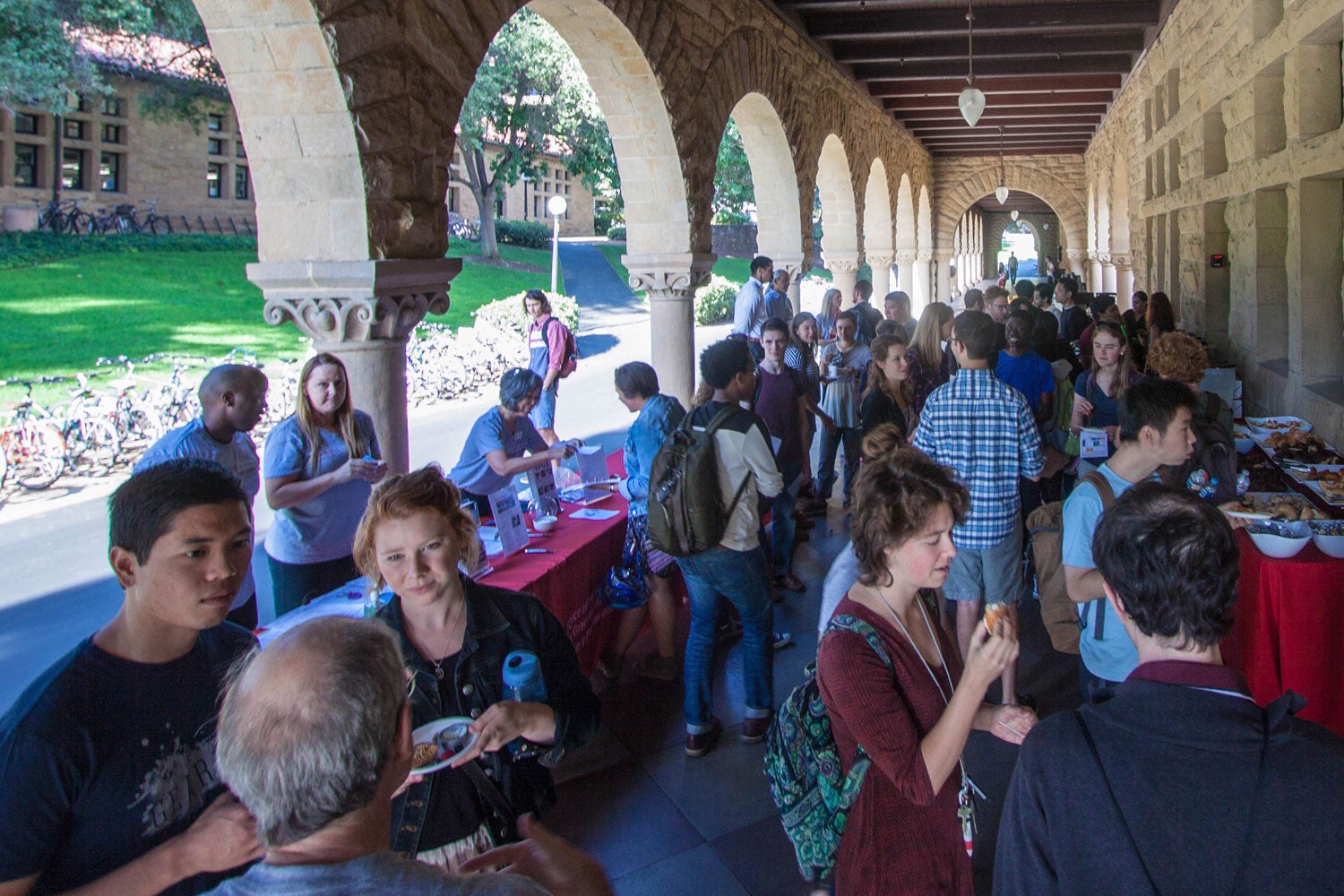Stanford welcomes new graduate students with tours, trainings, tackling drills
The New Graduate Student Orientation program is designed to help new graduate students make connections – with people, places and resources – across the entire campus.
New graduate students who recently completed a two-hour workshop, “American Football 101,” will be able to put their newfound knowledge to use Saturday when the Cardinal football team takes on the UCLA Bruins in Stanford Stadium.

The office of the Vice Provost for Graduate Education offered a resource fair and open house as part of New Graduate Student Orientation. (Image credit: Joshua Yim)
The workshop – tackling drills included – is one of more than two-dozen events scheduled during this week’s New Graduate Student Orientation (NGSO), which introduces incoming graduate students to the vast network of academic, career, health, athletics, social and recreational resources available on the Farm.
Ken Hsu, director of the Graduate Life Office, said the football workshop, which Stanford Athletics videotaped in 2016, is a popular event, especially among international students.
Library tours are also crowd pleasers among students who are about to begin master’s, doctoral and professional degree programs on the Farm. This week, librarians will discuss the collections in Terman Engineering Library, Bowes Art & Architecture Library, the Music Library and Green Library and the wondrous technology of the David Rumsey Map Center.
This year, 2,675 new graduate students are joining the Stanford community. Nearly 40 percent of them are international students, with China accounting for the lion’s share, followed by India, South Korea and Canada. The Bechtel International Center at Stanford provides a two-week orientation – Sept. 11-25 – for the international students, focused on their specialized needs, such as maintaining their legal status in the United States.
Nearly half of Stanford’s new graduate students – about 47 percent – are enrolled in master’s degree programs. Twenty-seven percent are enrolled in doctoral programs and 27 percent are pursuing professional degrees in business, law and medicine.
In addition to NGSO, which is open to graduate students across the university, new graduate students receive enthusiastic welcomes within their degree programs.
“These seven days of NGSO are designed to help graduate students get excited about campus life and to help them make connections – with people, places and resources – across campus,” Hsu said. “This week, they will begin their discovering and exploring within their academic programs, as well as within the rich array of personal, social and professional development opportunities and programs offered on campus.”
Hsu emphasized that the most important orientations for new graduate students are the events hosted by their programs, where they will meet their cohorts and learn everything they need to know about fulfilling the requirements for their degrees.
“Someone who is getting a PhD in linguistics will have a very different program orientation than someone getting a PhD in public policy,” he said, noting that Stanford has about 200 degree programs across the seven schools.
One of the annual highlights of the NGSO program is the President’s Reception hosted by Stanford President Marc Tessier-Lavigne and his wife, Mary Hynes, associate professor (research) of biology, in the gardens of Hoover House.
During the week, new graduate students will drop by White Plaza to register their bikes. They will tour the Stanford Recycling Center on the east side of campus for a behind-the-scenes look at how Stanford recycles and composts 64 percent of campus waste – a new event this year.
They will pick up free lunches and meander through an activities fair showcasing student organizations and helpful administrative and student affairs offices. They will be encouraged to look beyond their department, their school, their culture to make friends during another new event, “Breaking Bubbles and Shaking Misconceptions.”
They will get “insider” information on campus life from a panel of current graduate students. They will learn how to use the Graduate Professional Development Framework, an interactive tool designed to help graduate students connect their interests and goals with Stanford’s abundant resources and learning opportunities. They will learn about the many resources and experiences offered by the Office of the Vice Provost for Graduate Education.
“Over the past decade, Stanford has become distinctive nationally for developing innovative educational resources and community-building experiences that complement the specialized knowledge and training in their degree programs,” said Patricia J. Gumport, vice provost for graduate education and a professor of education.
“Our mindset is to expand what’s possible in graduate education, which aligns with and further strengthens Stanford’s interdisciplinary culture by encouraging graduate students to pursue ideas and develop connections across departments and schools.”
The Graduate Life Office relied on three doctoral students – Doreen Chan, chemistry; Shabnam Semnani, structural engineering and geomechanics; and Karthik Rajkumar, economics – to bring this year’s NGSO program to life. Together, they brainstormed ideas, chose a theme – “Discover and Explore” – reached out to campus partners, scheduled more than two dozen events, designed a brochure and ordered T-shirts.
“The most fun part was talking about and planning events with people around campus, hearing their ideas and contributing my own – and knowing that I would be able to make a difference in welcoming new graduate students,” said Chan.
Semnani is particularly excited about Saturday’s brunch mixer for couples and families – another new event this year.
“Most of the NGSO events are for new graduate students only,” Semnani said. “We created this welcoming event to provide a chance for couples and families to meet each other, and to obtain information about some of the campus resources available for partners, spouses and families of graduate students.”
Rajkumar, who began doing research full time this summer after two years of coursework, enjoyed taking a break from his research to help plan NGSO.
“The two things really complement each other,” Rajkumar said. “The more welcoming Stanford is as a new home and a community for students, the more productive we will be.”
